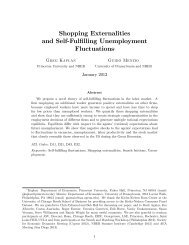A Dynamic Model of Housing Supply
A Dynamic Model of Housing Supply
A Dynamic Model of Housing Supply
Create successful ePaper yourself
Turn your PDF publications into a flip-book with our unique Google optimized e-Paper software.
where ˜η n h = ηn h · (1 − γ 1j(n)t ).The variation in the marginal revenue <strong>of</strong> adding square footage over neighborhoods and timehelps identify the cost coefficients. For example, if the return to square footage increases (falls)through time, we would expect the square footage <strong>of</strong> new construction to increase (fall). Theextent to which the square footage <strong>of</strong> new construction changes with price changes, either acrosstracts or through time, will identify the cost patterns. To highlight that size does indeed changeas returns increase, I regress the log <strong>of</strong> observed square footage for new construction on lot-size,tract dummies, and year dummies.log(sqft njt ) = κ 0 + κ t I [year=t] + κ j I [tract=j] + κ lot lot − size n + υ sqftnjtFigure 9 plots e κt against year, showing the time trend <strong>of</strong> square footage in new constructionbetween 1988 and 2004 and . It is worth noting that this regression is estimated using a differentdata set to the one that was used to estimate prices. Here, only new construction is used,whereas the price regression is run using all sales. The size <strong>of</strong> observed size changes relative toprice changes is what identifies the time trend in variable costs.Figure 9: Time Trend <strong>of</strong> Mean Square FootageFigures 10 illustrates the distribution over tracts in cost per square foot and Figure 11 showsthe time trend in cost per square foot The mean cost per square foot is $125. As the approach36
















